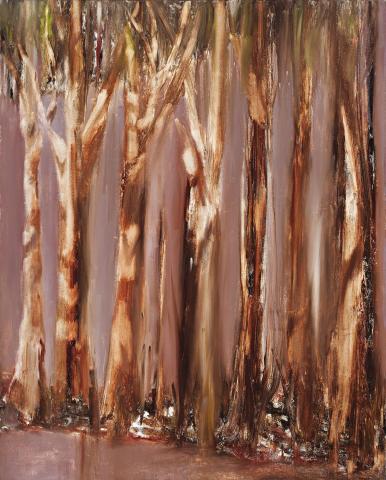RIVERBEND, 1966
SIDNEY NOLAN
oil on canvas
152.5 x 122.0 cm
signed indistinctly lower right: Nolan 1966
Stanley Bard, New York
The Stanley Bard Collection: Life at the Chelsea, Freeman's Auctions, Philadelphia, 16 May 2017, lot 43
Private collection, Melbourne
Riverbend, 1966, is a companion piece to two of Sidney Nolan’s multi-paneled masterworks, Riverbend I, 1964 – 65 (Australian National University); and Riverbend II, 1965 – 66 (News Limited, New York). It was previously part of one of America’s most eccentric collections, sited at New York’s infamous Chelsea Hotel where Nolan spent nearly five months living in a penthouse room from December 1965 to March 1966. Here, he worked at a feverish pace and created a range of vast narratives, all comprising nine panels, including the aforementioned Riverbend II, as well as Glenrowan, 1966 (Carnegie Museum of Art, Pittsburgh); Inferno, 1966 (on loan to the Art Gallery of South Australia); and Desert Storm, 1966 (Art Gallery of Western Australia). It was an incredibly fertile period and the painting on offer here provides significant insight into Nolan’s creative process at the time.
Until the mid-1950s, Nolan’s medium of choice was Ripolin enamel but by the end of the decade, he was using both oil paint applied with brushes and fingers, and pigment mixed into polyvinyl acetate spread over the surface using squeegees and scrapers. In 1964, he was able to re-engage with his original Ned Kelly paintings from 1946 – 47, then on exhibition in London. Having not seen them for nearly twenty years, Nolan embarked on a new interpretive series using oils and as they developed, so did his technique, to a point where the paint became decidedly wet and juicy in appearance, as if Kelly and his protagonists were mired in rain and mud, evocative of the tragic aura hanging over the whole saga. At the end of 1964, he commenced Riverbend I, an installation-like musing on the story, interwoven with the artist’s own familial memories and connection to the Goulburn River in Victoria. For Nolan, it was ‘really a reminiscence of a shallow river, a kind of billabong where the river winds round, that I walked in as a boy with my father. The bank falls in the water, and it’s very cool and smells of tannin’.1 Three months after its completion, Nolan’s father died and this event led him to execute a second, more contemplative version, this time on canvas instead of the composition board he had previously employed. Completed over a staggeringly short five-day period between 30 December 1965 and 3 January 1966, Riverbend II was originally intended for the 1967 Montreal Expo but was bought instead by Rupert Murdoch and now hangs in the boardroom of his New York offices.
By transferring to canvas, subtle differences appeared in the painterly application and Nolan created extra pieces, such as Riverbend, as he finalised the composition. Using a combination of sharp vertical trunks demarcated against a hazed and misty background, this painting is directly related to the sixth panel of Riverbend II where the ancient river gums have their roots partially submerged by the muddy waters. Like many other residents, Nolan probably gave the painting to the proprietor of the Chelsea Hotel, Stanley Bard, in lieu of rent for the expensive penthouse. In doing so, Riverbend joined other notable artworks in the Bard collection by artists such as Tom Wesselmann and Larry Rivers, as well as the Australians Brett Whiteley and Tony Woods.
1. The artist, 1969, quoted in Pearce, B., Sidney Nolan, Art Gallery of New South Wales, Sydney, 2007, p. 55
ANDREW GAYNOR
